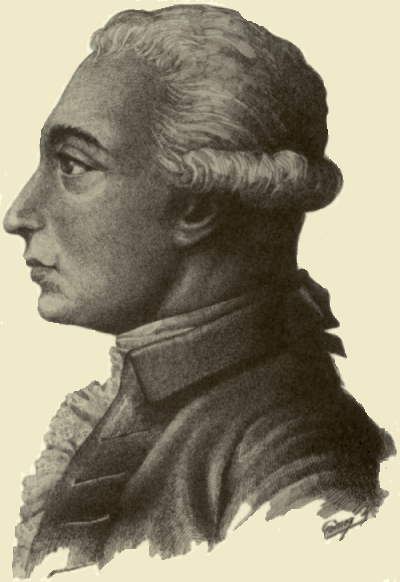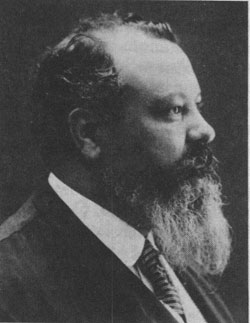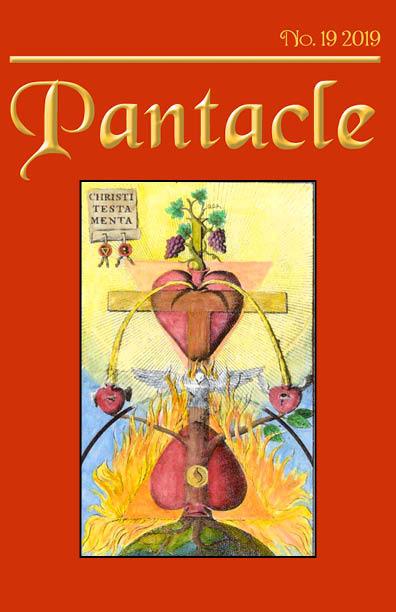Martinist History
Louis Claude de Saint-Martin
The writings of Louis Claude de Saint-Martin and Martinès de Pasqually form the foundations of the Martinist Teachings. The story of these two great mystics begins in the early eighteenth century. In the midst of the great political and economic unrest leading to the French Revolution, France paused to listen to a debonair, inspiring, mysterious man who awed both the nobility and the people with the high level of mysticism contained in his published writings. This author signed his books "The Unknown Philosopher." Where did his great understanding come from? He could have been easily mistaken for a Sophist, yet he possessed the gentleness and profound understanding of a philanthropist.

This person was Louis Claude de Saint-Martin. He dared to invade the salons of the wealthy aristocrats to challenge their jaded interests with inspiring discourses. He allowed himself to become the idol of French society with but one purpose—to draw their minds away from their meaningless, self-indulgent existence to contemplate humanity’s true position in the universe. He wished them to comprehend the natural connection existing between the Divine, humanity, and the universe, and to be conscious of the special place we once occupied in our original state and what happened to us during the course of time. Above all, he wanted them to learn how to regain this glorious former state.
The published writings of Louis Claude de Saint-Martin were read in France, Germany, England, and even in Russia. The knowledge that he imparted became known under the name of Martinism. This great teacher refused to take credit for what he taught, however, instead paying tribute to his initiators. To those who were worthy, he divulged the secret of a higher knowledge they could access. To attain it, they had to transform themselves, and their preparation was through initiation.
Martinès de Pasqually
The person to whom Louis Claude de Saint-Martin gave credit for his teachings was Martinès de Pasqually, a powerful mystic, adept, and theurgist of the eighteenth century. Tradition indicates he was well versed in the secret wisdom embodied in the esoteric teachings of Egypt, Greece, and the East. Shortly after 1760, Pasqually went to Bordeaux and established the headquarters for his order, The Masonic Élus-Cohen Knights of the Universe.
Saint-Martin, then an officer in the French Army, learned that one of his fellow officers was a member of this Order of the Élus-Cohens (Elect Priests). Through this friend, Saint-Martin met with the Supreme Master of the Order, Martinès de Pasqually, and was immediately captivated by the man’s goals and teachings.
After due preparation and demonstration of his worthiness, Saint-Martin was initiated into the Order of the Élus-Cohens in the year 1765, at age 22. He eventually attained the highest degree of that Order, that of Réau - Croix. However, Saint-Martin was not entirely won over by Pasqually’s methods, which called for theurgic rites, complicated ceremonies concerned with perceivable manifestations. Saint-Martin often asked Pasqually, "Master, is all that necessary in order to know the Divine?"
In 1772, personal matters compelled Pasqually to leave France for Port-au-Prince, Haiti, where he died in 1774. Without its founder, the Order progressively fell dormant. His two ablest disciples were Saint-Martin and Jean-Baptiste Willermoz. Willermoz joined with some members of the Élus-Cohens and the Order of the Strict German Templar Observance. They reorganized themselves by adopting part of the theoretical teachings of Martinès de Pasqually to create an order called “The Charitable Knights of the Holy City.” Others joined this Order, but Saint-Martin, seeing that they were not so much seeking the truth as the Philosopher's Stone, chose to follow an independent path.
Jakob Boehme
Saint-Martin traveled to England, Italy, and Germany to study humanity and nature and to compare the findings of others with his own. It was in Strasbourg, a city in northeast France, that he became acquainted with the works of Jakob Boehme (1575–1624), which revolutionized his whole mystical life. Jakob Boehme became for Saint-Martin his "second teacher."
In order to read Boehme's texts in their original language, Saint-Martin learned German at the age of forty-five. Through a study of Boehme, he realized that true initiation surpasses theurgic rituals; there is no need to call upon intermediary powers of creation through complex and often dangerous ceremonies. Initiation can only be produced with the heart. This is what is called "The Way of the Heart."
From this point until the end of his life, Saint-Martin made a daily task of translating the texts of Jakob Boehme. "I owe my entry into the higher truths to Martinès de Pasqually, and I owe the most important steps I have made into these truths to Jakob Boehme."
The Writings of Louis Claude de Saint-Martin
Saint-Martin published his first work in 1775 under the title Of Errors and Of Truth, or Humanity Recalled to the Universal Principle of Science. The book’s purpose was to combat the atheism of his time. As with all his other writings, this was published under the pseudonym of "The Unknown Philosopher."
During the many years of his literary activity, Louis Claude de Saint-Martin wrote numerous works, including The Natural View of the Connections Existing Between the Divine, Humanity, and the Universe; The Person of Desire; The New Person; The Spirit of Things; and The Ministry of the Human-Spirit. He also left to posterity a revealing and inspiring personal correspondence, as well as a few posthumous works. In addition, he published translations of the writings of the one he called his "most dear B" (Jakob Boehme): The Birth of Dawn; The Three Principles of the Divine Essence; Forty Questions on the Soul; The Triple Life of Humanity; and Six Points and Nine Texts.
Society of Intimates
The philosophical works of Louis Claude de Saint-Martin aroused much interest. In order to study his teachings, a circle of disciples was formed, known by the name of Society of Intimates. This society was working for the purest forms of spirituality. Saint-Martin accepted very few men and women into his society, always exercising extreme prudence.
Despite the political and social turbulence of the French Revolution, Louis Claude de Saint-Martin was never seriously harassed during the Reign of Terror, or at any other time during the Revolution. On October 13, 1803, at the age of sixty, Louis Claude de Saint-Martin went through transition following a stroke.
 Following Louis Claude de Saint-Martin’s death, the Martinist disciples were not very active. The traditional teachings and ceremonies were privately transmitted by groups of initiators, spreading principally throughout Italy, Germany, and France.
Following Louis Claude de Saint-Martin’s death, the Martinist disciples were not very active. The traditional teachings and ceremonies were privately transmitted by groups of initiators, spreading principally throughout Italy, Germany, and France.
The Martinist Order
After a long period of secrecy, a great effort was undertaken in 1888 to restructure Martinism into an initiatic order. It is due to the efforts of Dr. Gérard Encausse (Papus) and Augustin Chaboseau that this order survived and took on the name Martinist Order. Their efforts were rewarded with success in 1891 with the formation of a Supreme Council of the Martinist Order, consisting of twenty-one members with authority over all the lodges in the world. Papus, a well-known French esotericist, was elected the first President of the Supreme Council. Under his brilliant and tireless direction, the Order grew rapidly, and by 1900, it could account for several hundred members in most parts of the world.
Papus soon became an authority on Martinism, and his works constitute a precious source of information for Martinists and all those interested in the tradition.
World War I (1914–1918) greatly affected the growth and activities of the Order. Papus died heroically carrying out his duties as a medical doctor, and many other leaders and members of the Order did not survive. It was finally revived in 1931 due to the efforts of Augustin Chaboseau, the co-founder of the Martinist Order with Papus. He, along with the two other remaining survivors of the 1891 Supreme Council, created the Traditional Martinist Order to distinguish it from several movements which wrongly claimed to be the successors of Papus. Augustin Chaboseau, who was a descendant of an uninterrupted filiation back to Louis Claude de Saint-Martin, served as Grand Master and President of the Supreme Council until his transition on January 2, 1946.
The Traditional Martinist Order
Ralph Maxwell Lewis, Imperator of the Ancient and Mystical Order Rosae Crucis, was received into the Traditional Martinist Order on September 1, 1939. His Initiator was Georges Lagrèze, legate and representative of Augustin Chaboseau. Consequently, the charters, manifestos, and all other documents needed for the promotion and development of Martinism in the Americas were transmitted to Ralph M. Lewis just prior to the oppression which the Traditional Martinist Order had to endure in Europe during the Second World War.
Currently, the Supreme Council of the Traditional Martinist Order is directed and presided over by the Sovereign Grand Master, Claudio Mazzucco, Imperator of the Rosicrucian Order, AMORC. The Traditional Martinist Order goes back through an initiatic transmission that is absolutely authentic, to the purest sources of Martinism. Thus, the Martinist light has been able to shine and spread, without interruption, its original luster.
The Martinist Pantacle

“For our personal advancement in virtue and truth one quality is sufficient, namely, love; to advance humanity there must be two, love and intelligence; to accomplish the Great Work there must be three love, intelligence, and activity. And yet love is ever the root and the source.”
–Louis Claude de Saint Martin


